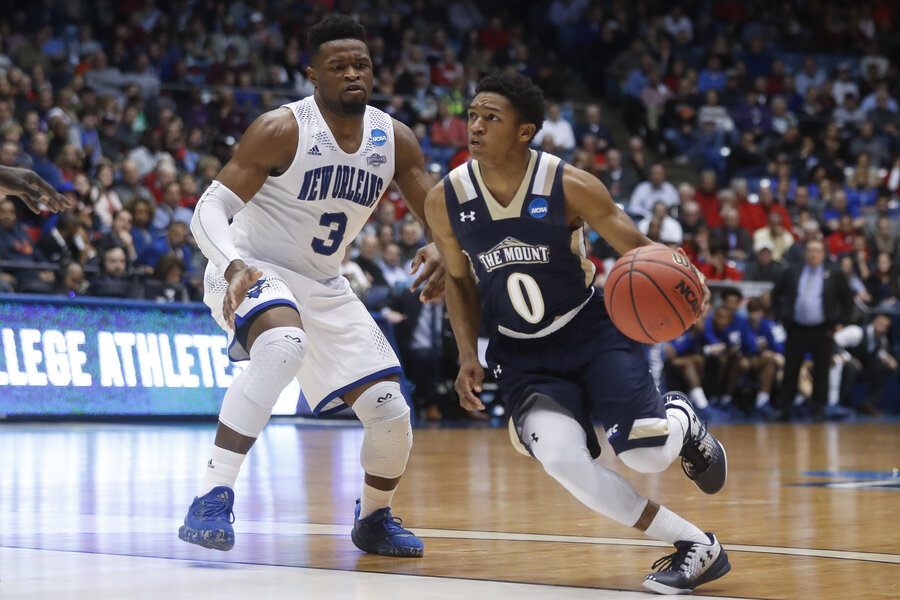In the NCAA March Madness basketball tournament, what’s a win worth to the little guys?
Loading...
In the closing seconds of Tuesday night’s First Four match, Mount St. Mary University’s forward Chris Wray raced forward to bat down a long inbounds pass, then ran away with the ball, sealing a tight victory over the University of New Orleans.
The win earned Mount St. Mary’s a long-shot chance against first-seeded Villanova on Thursday – and at least a few precious days of national limelight for the Emmitsburg, Md., university of just over 1,500 undergraduate students.
That sudden crest into prominence is, of course, a perennial one for the small colleges and universities who slip into the higher seeds of the NCAA tournament every spring. And for the vast majority of programs, such moments are hard to count on, making sports investment a tough gamble for small-university administrators trying to make up for schools' growing financial pressures. But they can also be deeply alluring for campuses faced with stiffening competition for students.
“I would say that it can be a net gain for schools just like playing the left column at a roulette table in Vegas can be a net gain for gamblers,” says Stephen Ross, the director of Pennsylvania State University’s Institute for Sports Law, Policy, and Research, in an interview with The Christian Science Monitor.
Underdogs like Mount St. Mary wouldn’t bring home a big prize even for the most unlikely of upsets, since per-win March Madness payouts are distributed, per NCAA rules, across the winner’s conference.
A few small colleges that pursued Division 1 sports programs have been able to parlay success into a stronger academic profile in the past, adds Mr. Ross. But there isn’t any literature examining how rare that crossover success really is.
If they're successful, "it puts them on the map," he says. "Student SAT scores go up, applications go up, alumni contributions go up. The question is for how many schools, and whether this is really a prudent investment for each school."
But "how many other schools have spent millions of dollars they could have spent on lower tuition or improved education on this pipe dream of athletic success?” he asks.
With state funding down and costs rising, public universities have generated ire in recent years for pouring money into coaches’ salaries and other aspects of Division 1 sports programs while slicing away academic budgets. It’s a decision, some charge, that ultimately promotes a university’s name at the cost of its raison d’être.
The fiscal picture at private colleges is more mixed. But a post-2011 decline in college enrollment has been particularly pronounced at smaller schools, especially those located in sparsely populated areas, as students are increasingly attending colleges closer to home, as the Washington Post reported this summer.
That could tempt administrators at small colleges to shift funding toward a Division 1 program – and 13 other school teams, the minimum number required by the NCAA for Division 1 certification – as a means of elevating the school’s national profile and generating school spirit.
“The fervor around the event itself makes it a community gathering point,” says Ellen Staurowsky, a professor at Drexel University’s Department of Sport Management who has studied college sports financing. “Some school administrators feel very strongly that this is the kind of rallying point that just can’t be created in any other way on campus, so there are clear benefits whether you have money coming in directly from the event or not.”
Should universities with scant room for error invest in athletic programs to drum up more applications and improve fundraising? It depends on how it’s done, Dr. Staurowsky tells the Monitor.
Would tournament win money be "like gravy for them, or are they living above their means and encountering a law of diminishing returns?" she asks. "I think it's that balancing act between whether or not you're growing your department within your means or taking too much risk."







